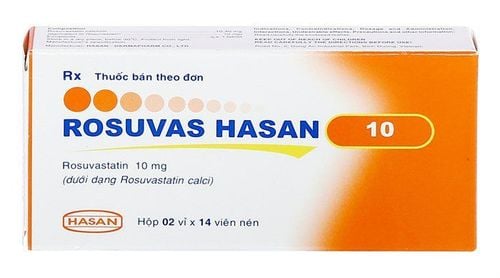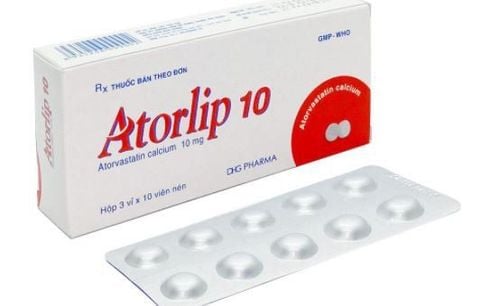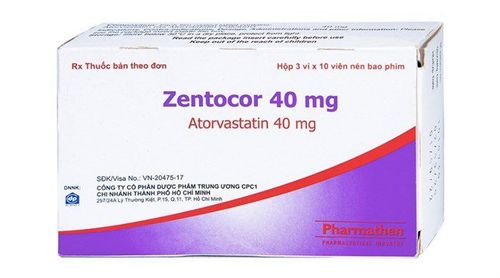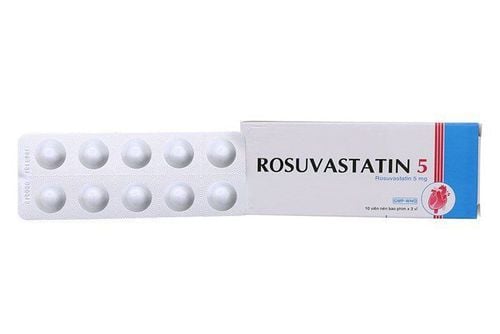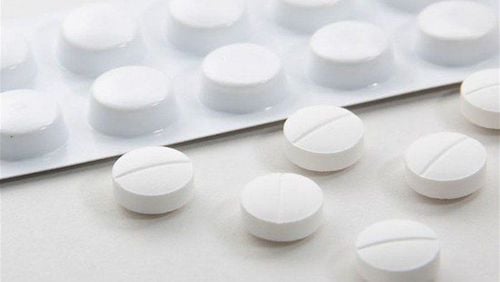This is an automatically translated article.
Drug Ipolipid 300 is manufactured by the company Medochemie Ltd, the drug has the main ingredient Gemfibrozil. Ipolipid 300 is used in the treatment of dyslipidemia. During the use of Ipolipid 300, patients need to follow the doctor's instructions to achieve the best treatment effect.
1. What is Ipolipid 300?
Ipolipid 300 belongs to the group of cardiovascular drugs, with the main active ingredient being Gemfibrozil.
Dosage form: film-coated tablets, each containing 300 mg Gemfibrozil and excipients just enough. Packing form: box of 5 blisters x 10 tablets or box of 10 blisters x 10 tablets.
2. Mechanism of action of Ipolipid
Pharmacodynamics:
Gemfibrozil is a drug to treat hyperlipidemia through the mechanism of reducing the concentration of very low density lipoprotein - VLDL (very low density lipoprotein) and increasing the concentration of high density lipoprotein - HDL (high density lipoprotein). . For VLDL, gemfibrozil increases lipoprotein lipase enzyme activity leading to increased breakdown of triglycerides present in VLDL and increased catabolism of VLDL. At the same time, gemfibrozil also works to reduce the formation of lipoprotein enzyme inhibitor apoC-III in the liver, thereby changing the composition of VLDL and reducing the formation of triglycerides of VLDL in the liver.
In addition, gemfibrozil reduces the risk of platelet aggregation, which reduces cardiovascular risk. This has been demonstrated in laboratory animals and in human clinical trials.
Studies have shown that taking Ipolipid at a dose of 900mg per day has the following effects:
Reduce triglyceride levels Reduce total cholesterol Reduce LDL - cholesterol Increase HDL - cholesterol Reduce the ratio of VLDL + LDL / HDL reduces the risk of fibrosis arteriosclerosis. Pharmacokinetics:
Absorption: When taken with meals, Ipolipid is rapidly and extensively absorbed (bioavailability: 98±1%). If drinking on an empty stomach, this rate is lower. Distribution: Ipolipid peaks in the blood 2 to 4 hours after oral administration. The half-life is 1.1 ± 0.2 hours. No drug accumulation was observed during long-term treatment. Metabolism: Ipolipid is metabolised mainly in the liver. The drug is mainly bound to plasma proteins (97%). Elimination: Ipolipid is excreted mainly as glucuronide conjugates. 70% is excreted in the urine, a small amount in the feces.
3. Indications and contraindications of Ipolipid 300
Ipolipid 300 is indicated in the following cases:
Primary prevention of coronary heart disease and myocardial infarction in people with hypercholesterolemia, dyslipidemia, hypertriglyceridemia type IIa, IIb and IV according to Fredrickson. Dyslipidemia type III and IV, accompanied by diabetes mellitus, jaundice. Adjuvant therapy in addition to diet to reduce the risk of coronary heart disease in group IIb patients with low HDL cholesterol, high LDL cholesterol, high triglycerides, no history of coronary heart disease, response to weight loss, exercise, treatment with nutrition and substances that lower LDL cholesterol and increase HDL cholesterol. Absolutely do not use Ipolipid 300 for the following subjects:
Patients who are sensitive to any ingredient in Ipolipid. Impaired liver and kidney function Under 18 years of age Having gallbladder disease and primary biliary cirrhosis There is a history of photosensitivity during treatment with fibrates.
4. Dosage and how to use Ipolipid
Pay attention to carefully read the instructions for using Ipolipid and absolutely follow the doctor's instructions, do not arbitrarily use other drugs or increase or decrease the dose. Do not give Ipolipid 300mg to other people even if they have the same symptoms as you because everyone's body is different.
Dosage for adults: 900 - 1200mg/day, divided into 2 times a day. Drink 30 minutes before breakfast and dinner. The maximum daily dose is 1500mg.
Children under 18 years of age: There are insufficient data on the safety of Ipolipid for this age group.
Treatment of overdose: Symptoms of overdose have been recorded including abdominal pain, diarrhea, nausea and vomiting, joint and muscle pain, increased CPK,... Patients and family members should contact immediately to the emergency center for treatment. When traveling, it is necessary to bring all the drugs that the patient uses, including vitamins, functional foods, ... Currently, there is no specific antidote to Ipolipid, only symptomatic and supportive treatment. In case of acute Ipolipid overdose, gastric emptying by induction of vomiting or gastric lavage is required. Management of missed dose: Take another dose as soon as you remember, maybe 1-2 hours after the scheduled time. If it is almost time for your next dose, skip the missed dose and continue taking it as planned. Do not take 2 doses next time to make up.
5. Side effects of Ipolipid 300mg
Ipolipid 300 may cause some side effects during treatment, including:
Digestive system: digestive disorders such as indigestion, diarrhea, constipation, nausea and vomiting, abdominal pain, acute appendicitis, gallstones Nervous system: dizziness, headache, fatigue, ... Skin: erythema, ezecma In addition to the above side effects, you may experience other side effects. Rare side effects have been reported including: blurred vision, sensory disturbances, dizziness, somnolence, depression, atrial fibrillation,...
Consult your doctor or pharmacist immediately if you have any unusual signs during the use of Ipolipid.
6. Some notes when using Ipolipid 300
Pregnancy: Ipolipid can cross the placenta. There are no adequate studies on the safety of Ipolipid in pregnancy and its toxicity to the fetus. Therefore, Ipolipid should not be used in pregnant women. Lactation: It is not known whether Ipolipid teeth are excreted in breast milk, so Ipolipid should not be used during lactation. Driving and operating machines: There is no adequate evidence on the effects of the drug on driving and operating machines.
7. Drug interactions
Ipolipid 300 may cause synergism or competition with other drugs you are taking. Therefore, to avoid drug interactions, you need to tell your doctor about all drugs and supplements you are using. Drugs that may interact with Ipolipid include:
Anticoagulants: reduce the dose of anticoagulants to prevent bleeding complications. HMG CoA reductase inhibitors (cerivastatin): severe myositis and rhabdomyolysis have been reported with concomitant use of Ipolipid. Bile agglutinin (colestipol): may reduce the bioavailability of Ipolipid. Therefore, these two drugs should be taken more than 2 hours apart.
8. Instructions for storing Ipolipid 300mg
Ipolipid 300 is a class B poison. Therefore, it should be kept out of reach of children and pets. Do not throw the medicine into the toilet or plumbing. Store Ipolipid in a sealed package, at a temperature below 30 degrees Celsius, in a dry place, away from direct light. Ipolipid has a shelf life of 36 months, before taking the medicine check to see if it has an expiry date.
Ipolipid 300 is used in the treatment of dyslipidemia. During the use of Ipolipid 300, patients need to follow the doctor's instructions to achieve the best treatment effect. Follow the website of Vinmec International General Hospital to get more health, nutrition and beauty information to protect the health of yourself and your loved ones in your family.
Please dial HOTLINE for more information or register for an appointment HERE. Download MyVinmec app to make appointments faster and to manage your bookings easily.




